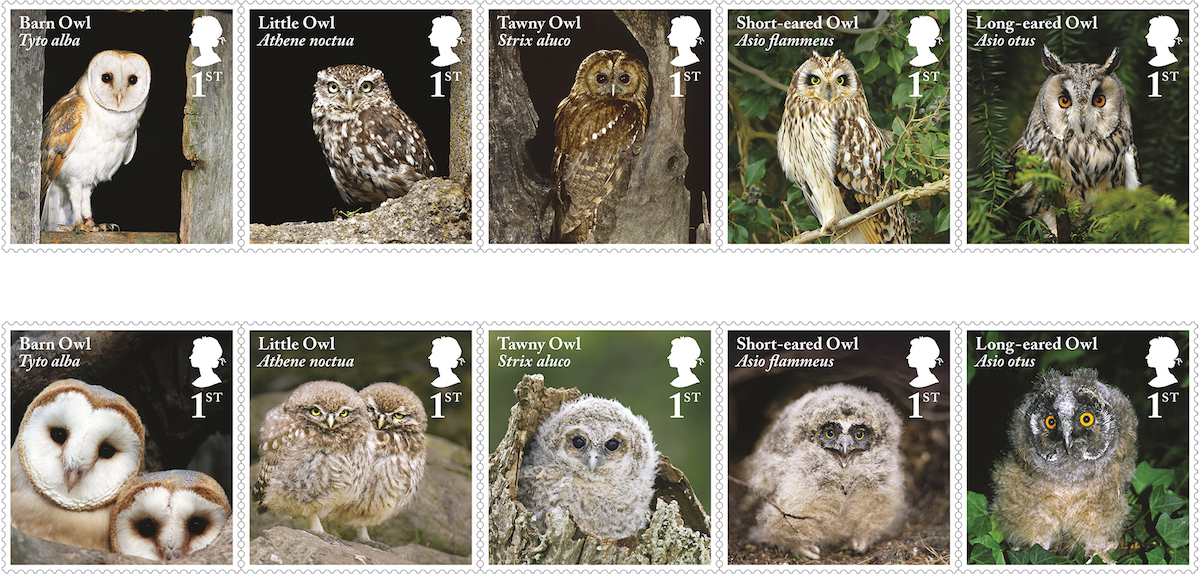Norvic Philatelics - GB New Stamps and Special Postmarks
British Owls - 11 May 2018
The Ten 1st class stamps
First row adults, Second row juveniles: Barn Owl, Little
Owl, Tawny Owl, Short-eared Owl, and Long-Eared Owl.
The stamps - all 1st Class
Barn Owl – Tyto alba
Also known as the ‘white owl’ and the ‘screech owl’, the Barn Owl is perhaps
the UK’s most familiar owl species – most often encountered as a ghostly
shape caught in car headlights, or heard rather than seen with its unearthly
screaming call. The Barn Owl hunts over all kinds of open country, and tends
to nest on ledges inside farm buildings. It is unmistakeable with its white
and gold plumage, heart-shaped face, long legs and small dark eyes.
While it is mostly nocturnal, it can also be seen out hunting on summer
evenings. It hunts in flight, flying into the breeze for uplift and often
hovering before making its strike – its prey mainly located by sound. Barn
Owls became very rare following widespread use of the insecticide DDT in the
20th century, but their numbers are now recovering.
Little Owl – Athene noctua
This small, long-legged owl with its bright yellow eyes, white-spotted brown
plumage and fiercely frowning expression is common in continental Europe,
but not native to the UK. It was deliberately introduced here by
ornithologists in the 19th century and has spread widely across southern
Britain. Little Owls inhabit woodland and parkland with open grassy areas
nearby, and are often seen by day, perched in pairs close to their nest site
(usually a hole or crack in a mature tree), or flying from tree to tree with
a distinctive bounding flight action.
They hunt mainly insects, dropping on them from a perch or chasing them on
the ground. The Little Owl is the national bird of Greece, and has long been
recognised as the emblem of Athene, the Greek goddess of wisdom.
Tawny Owl – Strix aluco
The lovely quavering hoot of the Tawny Owl is a familiar night-time sound in
woodland, parks and even gardens, but although this is the UK’s most common
owl, it is rarely seen, being strictly nocturnal. Tawny Owl pairs stay in
their territories year-round and over time build up a great familiarity with
the terrain, with favourite hunting watchpoints, roosting sites and a nest
site that will be used every year. The owlets leave the nest while still
downy and flightless, and climb to safe spots among the branches where they
wait for food from their parents.
The largest of the UK’s owl species, the Tawny Owl is a powerful predator
and other owls number among its prey. It is found throughout Great Britain,
but is absent from Ireland.
Short-eared Owl – Asio flammeus
A true nomad, the Short-eared Owl is one of the most widely distributed
birds in the world, occurring on all continents except Antarctica.
Individuals may travel great distances, stopping to breed where feeding
conditions are good. In Britain the species breeds mainly on upland moor in
the north and west, but becomes more widespread in winter (and more
numerous, as birds arrive from mainland Europe, sometimes in large numbers).
A diurnal owl of open moorland and rough grassland, it hunts on the wing,
patrolling back and forth close to the ground, and dropping feet-first upon
voles and other prey. In some winters, half a dozen or more may be seen
‘working’ the same field, with coastal areas particularly likely to attract
large numbers. The Short-eared Owl is a long-winged owl with grey-brown and
sandy, heavily streaked plumage, paler than the similar Long-eared Owl, and
with yellow, staring eyes and tiny ear tufts.
Long-eared Owl - Asio otus
This beautiful, slim, orange-eyed owl is named after its large, cat-like ear
tufts, which help to break up its outline as it roosts by day. In the UK it
breeds mainly in upland pine forests, but in Ireland (where it does not face
competition from Tawny Owls) it is more common and lives in a wider range of
habitats. Though the Long-eared Owl nests in woodland, often in the old nest
of another bird, it prefers to hunt on adjacent open countryside. Its prey
mainly comprises small rodents, which it catches either by pouncing from a
perch or by searching in flight.
The waiting chicks beg with a distinctive ‘squeaky-gate’ call. Long-eared
Owls disperse widely in winter, with residents joined by visitors from the
Continent, and form winter roosts (which may hold ten or more birds) in
thick scrubland.
Technical details:
The stamps were designed by Atelier Works. The 35 x 37 mm stamps
are printed by International Security Printers in lithography in 2 sheets
of 50, containing se-tenant strips of 5.
As the stamps will be issued in two sheets with five se-tenant designs
per sheet, customers may buy a vertical strip of five of any individual
bird.
Products issued, available from Royal Mail:
Set of 10 stamps (2 strips of 5) --
Strip of 5 from sheet 1 or sheet 2, or vertical strip of 5 of any single
stamp
First day cover --
Presentation pack -- Stamp
cards (set of 10)
Special Postmarks
Postmarks available for the day of
issue are shown on Royal Mail's Postmark Bulletin, download
from here.
(pdf)
If you would like to be contacted when this page is updated please
sign up on this ChangeDetection box:
If you have any questions, please email
us.
NB: all emails will be acknowledged in 1-2 days
unless we are away (see home page). If you do not receive an
acknowledgement please email us from a different address (eg hotmail,
gmail).
This page created 11 April 2018

